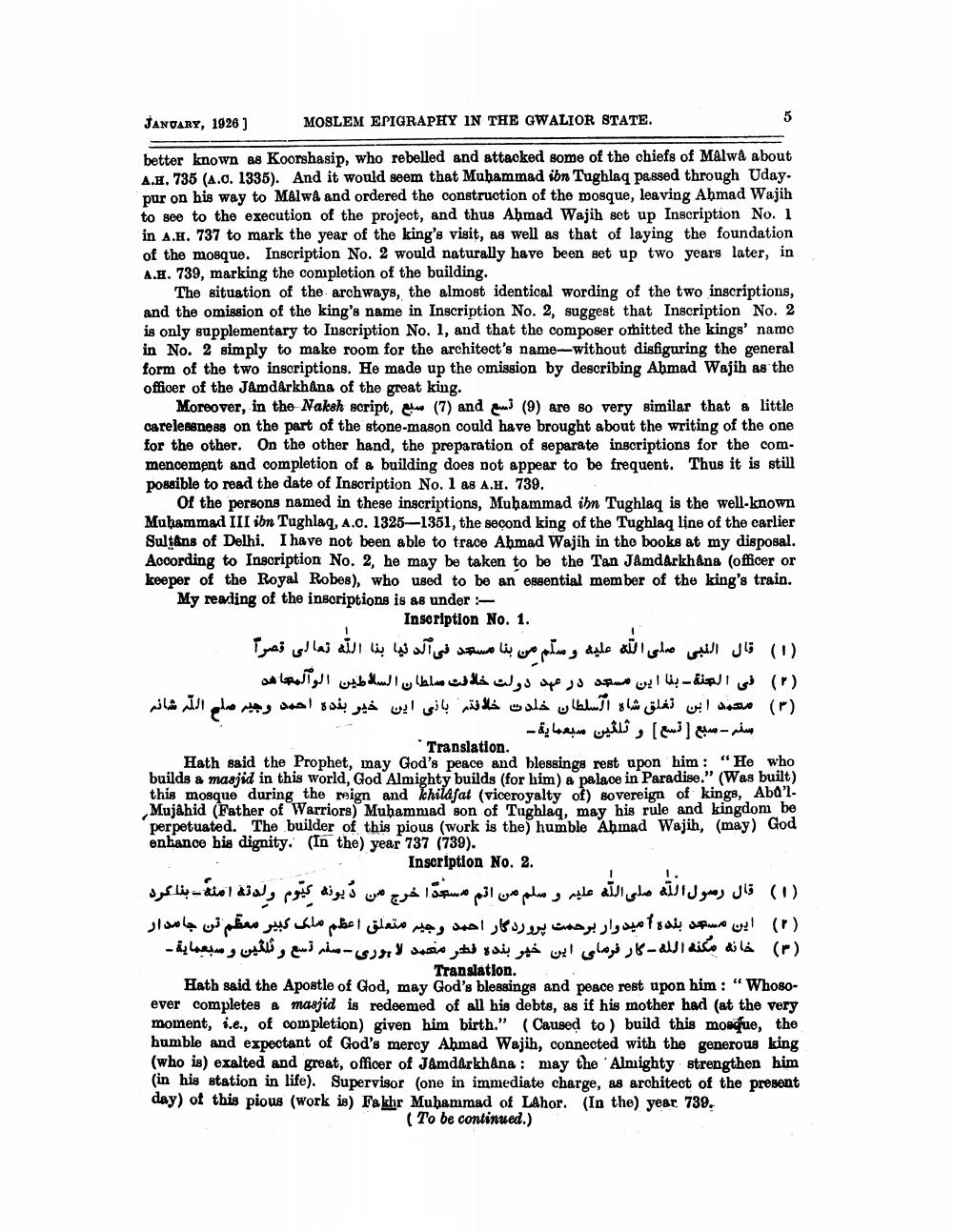________________
JANUARY, 1926 )
MOSLEM EPIGRAPHY IN THE GWALIOR STATE.
better known as Koorshasip, who rebelled and attacked some of the chiefs of Malwa about A.1. 735 (A.o. 1335). And it would seem that Muhammad ibn Tughlaq passed through Uday. pur on his way to Malwd and ordered the construction of the mosque, leaving Ahmad Wajih to see to the execution of the project, and thus Ahmad Wajih set up Inscription No. 1 in A.H. 737 to mark the year of the king's visit, as well as that of laying the foundation of the mosque. Inscription No. 2 would naturally have been set up two years later, in A.. 739, marking the completion of the building.
The situation of the archways, the almost identical wording of the two inscriptions, and the omission of the king's name in Inscription No. 2, suggest that Inscription No. 2 is only supplementary to Inscription No. 1, and that the composer omitted the kings' namo in No. 2 simply to make room for the architect's name-without disfiguring the general form of the two inscriptions. He made up the omission by describing Ahmad Wajih as the officer of the Jamdarkhana of the great king.
Moreover, in the Naksh script, (7) and awi (9) are so very similar that a little Carelessness on the part of the stone-mason could have brought about the writing of the one for the other. On the other hand, the preparation of separate inscriptions for the commencement and completion of a building does not appear to be frequent. Thus it is still possible to read the date of Inscription No. 1 as A.. 739.
Of the persons named in these inscriptions, Muhammad ibn Tughlaq is the well-known Muhammad III ibn Tughlaq, A.c. 1325-1351, the second king of the Tughlaq line of the carlier Sultans of Delhi. I have not been able to trace Ahmad Wajih in the books at my disposal. According to Inscription No. 2, he may be taken to be the Tan Jåmdarkhana (officer or keeper of the Royal Robes), who used to be an essential member of the king's train. My reading of the inscriptions is as under :
Inscription No. 1.
(1) قال النبي صلى الله عليه و سلم من بنا مسجد في الدنيا بنا الله تعالی قصرة (۲) في الجنة - بنا این مسجد در عهد دولت خلافت سلطان السلاطين الوآلمها هد (3) محمد ابن تغلق شاء السلطان خلدت خلافتہ بانی این خبر بنده احمد رجيم صلع التمر شانم
سنہ - سبع (تسع ) و ثلثين سبعماية -
* Translation. Hath said the Prophet, may God's peace and blessings rest upon him: "He who builds a masjid in this world, God Almighty builds (for him) a palace in Paradise." (Was built) this mosque during the reign and Khilafat (viceroyalty of) sovereign of kings, Abd'l. Mujahid (Father of Warriors) Muhammad son of Tughlaq, may his rule and kingdom be perpetuated. The builder of this pious work is the humble Ahmad Wajih, (may) God enhance his dignity. (In the) year 737 (739).
Inscription No. 2.
(1) قال رسول الله صلى الله عليه و سلم من اتم مسعد ا خرج من ديونه كيوم ولدته امله - بنا کرد (۲) این مسجد بند و امیدوار برحمت پروردگار احمد رجيم متعلق اعظم ملک کبير معظم تن جا مدار
خانه مكنه الله - کار فرمای این خبر بنده قطر محمد لاہوری - سنة تسع وثلثين و سبعماية - (۳)
Translation. Hath said the Apostle of God, may God's blessings and peace rest upon him: “Whosoever completes a masjid is redeemed of all his debts, as if his mother had (at the very moment, i.e., of completion given him birth." (Caused to build this moedue, the humble and expectant of God's mercy Ahmad Wajih, connected with the generous king (who is) exalted and great, officer of Jamdarkhana : may the Almighty strengthen him (in his station in life). Supervisor (one in immediate charge, as architect of the present day) of this pious (work is) Fakhr Muhammad of LAhor. (In the year. 739.
(To be continued.)




